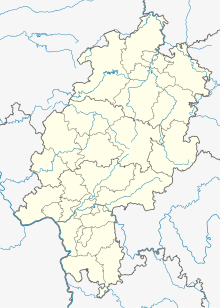Oberndorf (Geismar)
Coordinates: 51 ° 8 ′ 19 ″ N , 9 ° 13 ′ 51 ″ E
Oberndorf is a desert in the northwest of the district of Geismar , a district of Fritzlar in the north Hessian Schwalm-Eder district .
Geographical location
It is located about 202 m above sea level south of the state road L 2314 from Geismar to Züschen on the southern edge of the valley of the Elbe , which turns here from the north to the east.
history
The small settlement was first mentioned in a document in 1209, when the Fritzlarer St. Petri Stift received 12 bushels of tenth income and six shillings income from a manse in Oberndorf, but was probably inhabited long before: in the area of the desert, ceramics from the Carolingian era were made found. Today only the field name “im Oberndorf” reminds of the abandoned settlement.
Various religious institutions and aristocratic families in the surrounding area had property and / or tithes of income in the village, starting with the St. Petri monastery, which already collected its tithes in Oberndorf in 1209 and around 1450 and in 1273, 1310 and 1334 as the owner of Goods in place is notarized. The Lords of Wolfershausen and von Elben , who were related by marriage to them and who were declared to be the owners of a tithe in Oberndorf in 1260, waived their claims to property in Oberndorf in 1273 in favor of St. Petri-Stift. The Breitenau monastery is mentioned in 1279 and 1280 as the owner and in 1297 as the seller of several Huben in Oberndorf, and the Lords of Venne had pledged property until 1280 and own property in 1315 . The apparently wealthy Fritzlar priest Gumpert de Fovea bought land in Oberndorf in 1315 and 1316, as well as the Haina monastery in 1317 , and in 1334 the von Elben sold their goods to the St. Petri Stift in Oberndorf.
It is not known when the place was abandoned, but it was probably in the early 14th century.
Footnotes
- ↑ The spelling of the place name appears in changing forms over time: Oberindorf (1260), Oberendorph (1273), Overendorp (1273), Oberndorf (1280), Hoberndorf (1316), Oberndorff (1334), Obirndorf (around 1340), Obrendorf (around 1340), Overendorf (around 1340) and finally Oberdorff (1579).
- ↑ Hermann the Elder J. and Heinrich von Wolfershausen had to accept the complete destruction of their Wolfershausen castle in the course of a feud with the city of Fritzlar and the St. Petri-Stift, which they had inflicted serious damage with raids ( Carl Bernhard Nicolaus Falckenheiner: History of Hessian Cities and Donor, Volume I. Fischer (Krieger'sche Buchhandlung), Kassel, 1841, pp. 245–246 ) and were forced to renounce this.
literature
- Werner Ide: From Adorf to Zwesten. Local history pocket book for the Fritzlar-Homberg district. A. Bernecker, Melsungen, 1971, p. 288
- Waldemar Küther: Historical local dictionary Fritzlar-Homberg. Elwert, Marburg, 1980, ISBN 3-7708-0679-4 , p. 236
- Georg Landau : Historical-topographical description of the desert towns in the Electorate of Hesse . Fischer, Kassel, 1858, p. 156
- Heinrich Reimer: Historical local dictionary for Kurhessen. Elwert, Marburg, reprint 1974, ISBN 3-7708-0509-7 , p. 357.
Web links
- Oberndorf, Schwalm-Eder-Kreis, in the Historisches Ortlexikon Hessen , accessed on January 29, 2020
